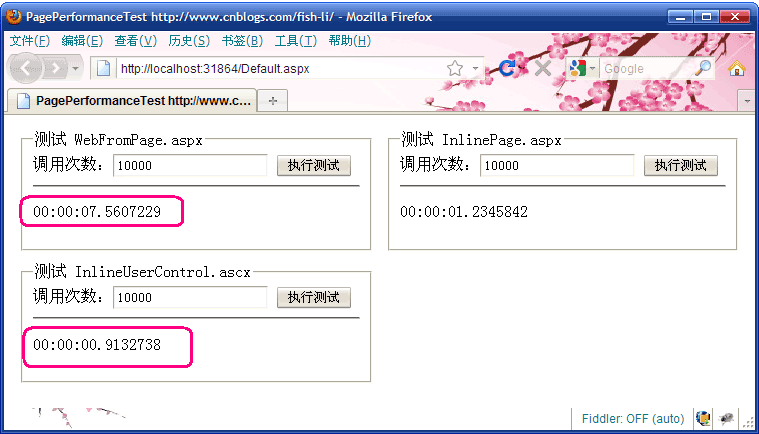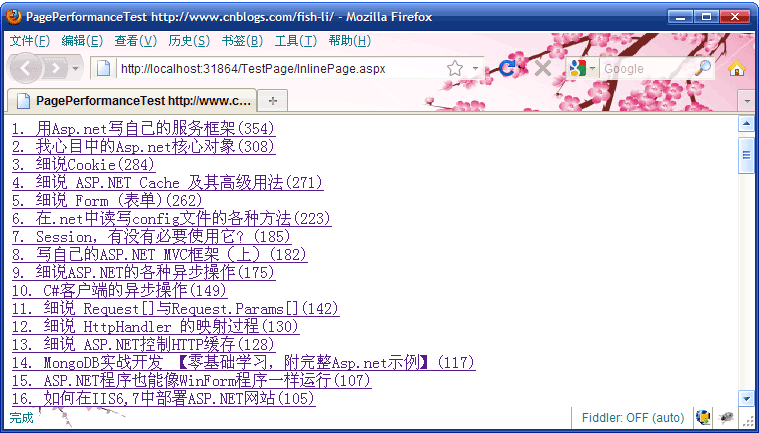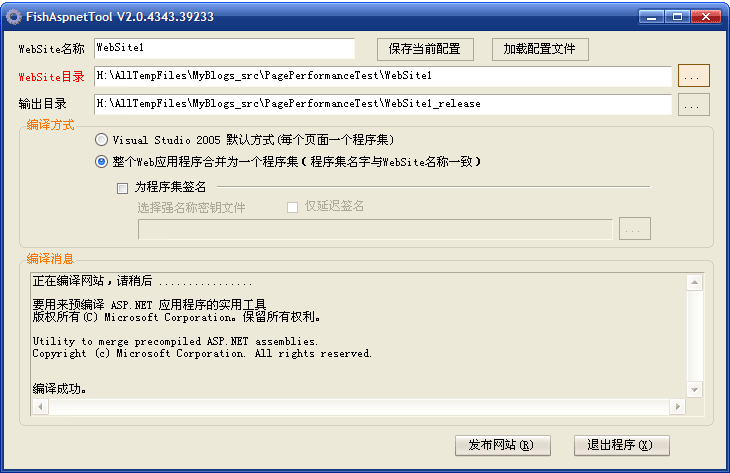為了讓您對優化的效果有個直觀的了解,我准備了下面的測試結果截圖:

測試環境:
1. Windows Server 2003 SP2
2. Viaual Studio 2008,使用自帶的WebDev.WebServer.EXE運行網站程序。
3. (ThinkPad SL510):Core2 T6670 2.2GHz, 4G內存
二個紅框中的數字反映了優化前後的執行時間。
數字表明:優化前後,執行時間有了8倍多的差別。
測試背景
看過了優化結果,再來介紹一下:這個測試到底是在測試什麼東西?
現在有很多做ASP.NET的開發人員,應該都是從ASP.NET的WebForm編程模型開始學習的。大家都很喜歡用服務器控件,不管輸出什麼,都會使用服務器控件。有時候為了讓頁面呈現干淨的HTML代碼,有些人會選擇使用Repeater,Literal這類簡單的服務器控件。或許有些人認為:我已不使用GridView這樣強大復雜的控件,頁面執行速度已經很快了。
真是這樣嗎?
今天測試的起點就從使用簡單的服務器開始,我會分二次對它做一系列的性能優化。
最終就是上圖中的3個結果,它們反映了二次優化的改進過程。
在繼續介紹之前,有一點我想有必要說明一下:
優化的過程涉及到ASP.NET服務器控件的使用,測試結果也僅僅只是一個參考數字。
如果您認為您的開發工作非常依賴於服務器控件的使用,
那麼測試結果對您來說其實是無意義的,請不要在意這個結果。
測試方法
在這次優化過程中,我並沒有設計很復雜的測試頁面,而是一個很簡單的測試頁面,頁面顯示效果如下:

這個頁面其實就是顯示了一堆超鏈接,它們來自於我的博客側邊欄的【推薦排行榜】,總共有20條記錄,我讓頁面重復5次輸出,也就是生成了100個超鏈接。
測試的數據是這樣獲取的:
我復制了我的博客側邊欄的【推薦排行榜】的那段HTML代碼,保存到一個文件中:

然後,網站在初始化時,從這段HTML代碼提取鏈接地址以及顯示文字,保存到一個BlogInfo的列表中,代碼如下:
復制代碼 代碼如下:
public class BlogInfo
{
public string Title;
public string Href;
}
public static class XmlDb
{
public static List<BlogInfo> Blogs { get; private set; }
public static void LoadBlogs()
{
string filePath = Path.Combine(HttpRuntime.AppDomainAppPath, @"App_Data\RecommendList.html");
XElement html = XElement.Parse(System.IO.File.ReadAllText(filePath));
Blogs =
(from a in html.Elements("li").Elements("a")
select new BlogInfo { Title = a.Value, Href = a.Attribute("href").Value }).ToList();
}
}
測試時,就把XmlDb.Blogs的內容顯示在網頁中。
我想這個測試還是比較接近於現實開發的。
這裡又有一個問題:我如何測試頁面的執行速度?
雖然說創建HttpWebRequest訪問頁面是個很簡單的方法,但我並不打算這樣做。
因為從HttpWebRequest發起調用到獲取結果,這其中除了有頁面的執行時間,還混雜較多的額外調用開銷。最終,我選擇了在一次HTTP請求中,循環調用Server.Execute來執行頁面,並統計時間的方式。其實如何選擇測試方法,對於二個測試對象還說,都是公平的。只是說:盡量減少一些額外的調用開銷,會讓測試結果的差異更大,也更明顯。
說明:為了測試代碼寫起來簡單,我使用了MyMVC框架。
測試用例1:WebFromPage.aspx
前面介紹了測試背景以及測試方法。現在就來介紹第1個測試用例,它采用了WebForm編程模型中最經典的寫法。
頁面代碼:
復制代碼 代碼如下:
<%@ Page Language="C#" CodeFile="WebFromPage.aspx.cs" Inherits="TestPage_WebFromPage" %>
<html xmlns="http://www.w3.org/1999/xhtml">
<head>
<title>PagePerformanceTest http://www.cnblogs.com/fish-li/</title>
</head>
<body>
<p>This is WebFromPage.aspx</p>
<asp:Repeater ID="repeater1" runat="server" onitemdatabound="repeater1_ItemDataBound">
<ItemTemplate>
<asp:HyperLink ID="link1" runat="server"></asp:HyperLink><br />
</ItemTemplate>
<FooterTemplate><hr /></FooterTemplate>
</asp:Repeater>
<asp:Repeater ID="repeater2" runat="server" onitemdatabound="repeater1_ItemDataBound">
<ItemTemplate>
<asp:HyperLink ID="link1" runat="server"></asp:HyperLink><br />
</ItemTemplate>
<FooterTemplate><hr /></FooterTemplate>
</asp:Repeater>
<asp:Repeater ID="repeater3" runat="server" onitemdatabound="repeater1_ItemDataBound">
<ItemTemplate>
<asp:HyperLink ID="link1" runat="server"></asp:HyperLink><br />
</ItemTemplate>
<FooterTemplate><hr /></FooterTemplate>
</asp:Repeater>
<asp:Repeater ID="repeater4" runat="server" onitemdatabound="repeater1_ItemDataBound">
<ItemTemplate>
<asp:HyperLink ID="link1" runat="server"></asp:HyperLink><br />
</ItemTemplate>
<FooterTemplate><hr /></FooterTemplate>
</asp:Repeater>
<asp:Repeater ID="repeater5" runat="server" onitemdatabound="repeater1_ItemDataBound">
<ItemTemplate>
<asp:HyperLink ID="link1" runat="server"></asp:HyperLink><br />
</ItemTemplate>
<FooterTemplate><hr /></FooterTemplate>
</asp:Repeater>
</body>
</html>
頁面的CodeFile代碼:
復制代碼 代碼如下:
public partial class TestPage_WebFromPage : System.Web.UI.Page
{
protected override void OnLoad(EventArgs e)
{
base.OnLoad(e);
repeater1.DataSource = XmlDb.Blogs;
repeater1.DataBind();
repeater2.DataSource = XmlDb.Blogs;
repeater2.DataBind();
repeater3.DataSource = XmlDb.Blogs;
repeater3.DataBind();
repeater4.DataSource = XmlDb.Blogs;
repeater4.DataBind();
repeater5.DataSource = XmlDb.Blogs;
repeater5.DataBind();
}
protected void repeater1_ItemDataBound(object sender, RepeaterItemEventArgs e)
{
if( e.Item.ItemType == ListItemType.Item ) {
BlogInfo blog = e.Item.DataItem as BlogInfo;
HyperLink link1 = e.Item.FindControl("link1") as HyperLink;
link1.NavigateUrl = blog.Href;
link1.Text = blog.Title;
}
}
}
測試代碼:
復制代碼 代碼如下:
[Action]
public object Test1(string callTimes)
{
int count = 0;
int.TryParse(callTimes, out count);
if( count <= 0 )
return count;
HttpContext context = HttpContext.Current;
// 先執行一次,排除編譯時間
string html = MyMVC.PageExecutor.Render(context, "/TestPage/WebFromPage.aspx", null);
Stopwatch watch = Stopwatch.StartNew();
for( int i = 0; i < count; i++ )
html = MyMVC.PageExecutor.Render(context, "/TestPage/WebFromPage.aspx", null);
watch.Stop();
return watch.Elapsed.ToString();
}
當我測試執行10000次時,耗時:00:00:07.5607229
回到頂部
測試用例2:InlinePage.aspx
與測試用例1不同,測試用例2則完全不使用服務器控件。
頁面代碼:
復制代碼 代碼如下:
<%@ Page Language="C#" %>
<html xmlns="http://www.w3.org/1999/xhtml">
<head>
<title>PagePerformanceTest http://www.cnblogs.com/fish-li/</title>
</head>
<body>
<p>This is InlinePage.aspx</p>
<% foreach( BlogInfo b in XmlDb.Blogs ) { %>
<a href="<%= b.Href %>" target="_blank"><%= b.Title %></a><br />
<% } %>
<hr />
<% foreach( BlogInfo b in XmlDb.Blogs ) { %>
<a href="<%= b.Href %>" target="_blank"><%= b.Title %></a><br />
<% } %>
<hr />
<% foreach( BlogInfo b in XmlDb.Blogs ) { %>
<a href="<%= b.Href %>" target="_blank"><%= b.Title %></a><br />
<% } %>
<hr />
<% foreach( BlogInfo b in XmlDb.Blogs ) { %>
<a href="<%= b.Href %>" target="_blank"><%= b.Title %></a><br />
<% } %>
<hr />
<% foreach( BlogInfo b in XmlDb.Blogs ) { %>
<a href="<%= b.Href %>" target="_blank"><%= b.Title %></a><br />
<% } %>
<hr />
</body>
</html>
測試代碼:
復制代碼 代碼如下:
[Action]
public object Test2(string callTimes)
{
int count = 0;
int.TryParse(callTimes, out count);
if( count <= 0 )
return count;
HttpContext context = HttpContext.Current;
// 先執行一次,排除編譯時間
string html = MyMVC.PageExecutor.Render(context, "/TestPage/InlinePage.aspx", null);
Stopwatch watch = Stopwatch.StartNew();
for( int i = 0; i < count; i++ )
html = MyMVC.PageExecutor.Render(context, "/TestPage/InlinePage.aspx", null);
watch.Stop();
return watch.Elapsed.ToString();
}
當我測試執行10000次時,耗時:00:00:01.2345842
回到頂部
分析優化結果1
測試用例1執行相同次數所花費的時間是測試用例2的6倍,為什麼會這樣呢?
為了回答這個問題,我們首先要知道前面二個頁面在執行時,它們是如何運行的。
說到這裡,就不得不談ASP.NET的頁面編譯方式了。
ASP.NET的頁面編譯過程是個復雜的操作,其實我們可以不用關心頁面是如何編譯的,
但要知道:頁面編譯後是什麼樣的。
為了能直觀地了解頁面編譯後的樣子,我編譯了整個網站,並生成到一個DLL文件中,然後使用Reflector.exe來分析這個DLL的源代碼。
將網站編譯成一個DLL文件有二個方法:
1. 安裝WebDeployment插件。
2. 使用我的工具:FishAspnetTool
本文將使用FishAspnetTool來編譯測試網站獲得編譯後的DLL文件。
FishAspnetTool是什麼?
FishAspnetTool是我在使用Visual Web Developer 2005時,為了方便編譯網站而寫的一個小工具。
下載地址:http://www.jb51.net/article/29875.htm
注意:下載的是一個工具包,安裝後,從開始菜單中運行FishTools\FishAspnetTool即可。
下面是工具的運行截圖。

操作方法:
1. 點擊粉色按鈕,選擇網站路徑。
2. 單選按鈕選擇第2項。
3. 點擊【發布網站】按鈕。
在編譯網站之後,我就可以知道網站在運行時如何運行頁面了。
測試用例1的頁面,最後被編譯成這樣了:
復制代碼 代碼如下:
namespace ASP
{
using System;
using System.Diagnostics;
using System.Runtime.CompilerServices;
using System.Web;
using System.Web.UI;
using System.Web.UI.WebControls;
[CompilerGlobalScope]
public class testpage_webfrompage_aspx : TestPage_WebFromPage, IHttpHandler
{
private static object __fileDependencies;
private static bool __initialized;
[DebuggerNonUserCode]
public testpage_webfrompage_aspx()
{
base.AppRelativeVirtualPath = "~/TestPage/WebFromPage.aspx";
if (!__initialized)
{
string[] virtualFileDependencies = new string[] { "~/TestPage/WebFromPage.aspx", "~/TestPage/WebFromPage.aspx.cs" };
__fileDependencies = base.GetWrappedFileDependencies(virtualFileDependencies);
__initialized = true;
}
base.Server.ScriptTimeout = 0x1c9c380;
}
[DebuggerNonUserCode]
private void __BuildControl__control10(Control __ctrl)
{
IParserAccessor accessor = __ctrl;
accessor.AddParsedSubObject(new LiteralControl("<hr />"));
}
[DebuggerNonUserCode]
private void __BuildControl__control11(Control __ctrl)
{
IParserAccessor accessor = __ctrl;
accessor.AddParsedSubObject(new LiteralControl("\r\n\t"));
HyperLink link = this.__BuildControl__control12();
accessor.AddParsedSubObject(link);
accessor.AddParsedSubObject(new LiteralControl("<br />\r\n"));
}
[DebuggerNonUserCode]
private HyperLink __BuildControl__control12()
{
HyperLink link = new HyperLink {
TemplateControl = this
};
link.ApplyStyleSheetSkin(this);
link.ID = "link1";
return link;
}
[DebuggerNonUserCode]
private void __BuildControl__control13(Control __ctrl)
{
IParserAccessor accessor = __ctrl;
accessor.AddParsedSubObject(new LiteralControl("<hr />"));
}
[DebuggerNonUserCode]
private void __BuildControl__control14(Control __ctrl)
{
IParserAccessor accessor = __ctrl;
accessor.AddParsedSubObject(new LiteralControl("\r\n\t"));
HyperLink link = this.__BuildControl__control15();
accessor.AddParsedSubObject(link);
accessor.AddParsedSubObject(new LiteralControl("<br />\r\n"));
}
[DebuggerNonUserCode]
private HyperLink __BuildControl__control15()
{
HyperLink link = new HyperLink {
TemplateControl = this
};
link.ApplyStyleSheetSkin(this);
link.ID = "link1";
return link;
}
[DebuggerNonUserCode]
private void __BuildControl__control16(Control __ctrl)
{
IParserAccessor accessor = __ctrl;
accessor.AddParsedSubObject(new LiteralControl("<hr />"));
}
[DebuggerNonUserCode]
private void __BuildControl__control2(Control __ctrl)
{
IParserAccessor accessor = __ctrl;
accessor.AddParsedSubObject(new LiteralControl("\r\n\t"));
HyperLink link = this.__BuildControl__control3();
accessor.AddParsedSubObject(link);
accessor.AddParsedSubObject(new LiteralControl("<br />\r\n"));
}
[DebuggerNonUserCode]
private HyperLink __BuildControl__control3()
{
HyperLink link = new HyperLink {
TemplateControl = this
};
link.ApplyStyleSheetSkin(this);
link.ID = "link1";
return link;
}
[DebuggerNonUserCode]
private void __BuildControl__control4(Control __ctrl)
{
IParserAccessor accessor = __ctrl;
accessor.AddParsedSubObject(new LiteralControl("<hr />"));
}
[DebuggerNonUserCode]
private void __BuildControl__control5(Control __ctrl)
{
IParserAccessor accessor = __ctrl;
accessor.AddParsedSubObject(new LiteralControl("\r\n\t"));
HyperLink link = this.__BuildControl__control6();
accessor.AddParsedSubObject(link);
accessor.AddParsedSubObject(new LiteralControl("<br />\r\n"));
}
[DebuggerNonUserCode]
private HyperLink __BuildControl__control6()
{
HyperLink link = new HyperLink {
TemplateControl = this
};
link.ApplyStyleSheetSkin(this);
link.ID = "link1";
return link;
}
[DebuggerNonUserCode]
private void __BuildControl__control7(Control __ctrl)
{
IParserAccessor accessor = __ctrl;
accessor.AddParsedSubObject(new LiteralControl("<hr />"));
}
[DebuggerNonUserCode]
private void __BuildControl__control8(Control __ctrl)
{
IParserAccessor accessor = __ctrl;
accessor.AddParsedSubObject(new LiteralControl("\r\n\t"));
HyperLink link = this.__BuildControl__control9();
accessor.AddParsedSubObject(link);
accessor.AddParsedSubObject(new LiteralControl("<br />\r\n"));
}
[DebuggerNonUserCode]
private HyperLink __BuildControl__control9()
{
HyperLink link = new HyperLink {
TemplateControl = this
};
link.ApplyStyleSheetSkin(this);
link.ID = "link1";
return link;
}
[DebuggerNonUserCode]
private Repeater __BuildControlrepeater1()
{
Repeater repeater = new Repeater();
base.repeater1 = repeater;
repeater.ItemTemplate = new CompiledTemplateBuilder(new BuildTemplateMethod(this.__BuildControl__control2));
repeater.FooterTemplate = new CompiledTemplateBuilder(new BuildTemplateMethod(this.__BuildControl__control4));
repeater.ID = "repeater1";
repeater.ItemDataBound += new RepeaterItemEventHandler(this.repeater1_ItemDataBound);
return repeater;
}
[DebuggerNonUserCode]
private Repeater __BuildControlrepeater2()
{
Repeater repeater = new Repeater();
base.repeater2 = repeater;
repeater.ItemTemplate = new CompiledTemplateBuilder(new BuildTemplateMethod(this.__BuildControl__control5));
repeater.FooterTemplate = new CompiledTemplateBuilder(new BuildTemplateMethod(this.__BuildControl__control7));
repeater.ID = "repeater2";
repeater.ItemDataBound += new RepeaterItemEventHandler(this.repeater1_ItemDataBound);
return repeater;
}
[DebuggerNonUserCode]
private Repeater __BuildControlrepeater3()
{
Repeater repeater = new Repeater();
base.repeater3 = repeater;
repeater.ItemTemplate = new CompiledTemplateBuilder(new BuildTemplateMethod(this.__BuildControl__control8));
repeater.FooterTemplate = new CompiledTemplateBuilder(new BuildTemplateMethod(this.__BuildControl__control10));
repeater.ID = "repeater3";
repeater.ItemDataBound += new RepeaterItemEventHandler(this.repeater1_ItemDataBound);
return repeater;
}
[DebuggerNonUserCode]
private Repeater __BuildControlrepeater4()
{
Repeater repeater = new Repeater();
base.repeater4 = repeater;
repeater.ItemTemplate = new CompiledTemplateBuilder(new BuildTemplateMethod(this.__BuildControl__control11));
repeater.FooterTemplate = new CompiledTemplateBuilder(new BuildTemplateMethod(this.__BuildControl__control13));
repeater.ID = "repeater4";
repeater.ItemDataBound += new RepeaterItemEventHandler(this.repeater1_ItemDataBound);
return repeater;
}
[DebuggerNonUserCode]
private Repeater __BuildControlrepeater5()
{
Repeater repeater = new Repeater();
base.repeater5 = repeater;
repeater.ItemTemplate = new CompiledTemplateBuilder(new BuildTemplateMethod(this.__BuildControl__control14));
repeater.FooterTemplate = new CompiledTemplateBuilder(new BuildTemplateMethod(this.__BuildControl__control16));
repeater.ID = "repeater5";
repeater.ItemDataBound += new RepeaterItemEventHandler(this.repeater1_ItemDataBound);
return repeater;
}
[DebuggerNonUserCode]
private void __BuildControlTree(testpage_webfrompage_aspx __ctrl)
{
__ctrl.EnableViewState = false;
__ctrl.EnableViewStateMac = false;
this.InitializeCulture();
IParserAccessor accessor = __ctrl;
accessor.AddParsedSubObject(new LiteralControl("\r\n\r\n<html xmlns=\"http://www.w3.org/1999/xhtml\">\r\n<head>\r\n <title>PagePerformanceTest http://www.cnblogs.com/fish-li/</title>\r\n</head>\r\n<body>\r\n\r\n<p>This is WebFromPage.aspx</p>\r\n\r\n"));
Repeater repeater = this.__BuildControlrepeater1();
accessor.AddParsedSubObject(repeater);
accessor.AddParsedSubObject(new LiteralControl("\r\n\r\n"));
Repeater repeater2 = this.__BuildControlrepeater2();
accessor.AddParsedSubObject(repeater2);
accessor.AddParsedSubObject(new LiteralControl("\r\n\r\n"));
Repeater repeater3 = this.__BuildControlrepeater3();
accessor.AddParsedSubObject(repeater3);
accessor.AddParsedSubObject(new LiteralControl("\r\n\r\n"));
Repeater repeater4 = this.__BuildControlrepeater4();
accessor.AddParsedSubObject(repeater4);
accessor.AddParsedSubObject(new LiteralControl("\r\n\r\n"));
Repeater repeater5 = this.__BuildControlrepeater5();
accessor.AddParsedSubObject(repeater5);
accessor.AddParsedSubObject(new LiteralControl("\r\n\r\n\r\n</body>\r\n</html>\r\n"));
}
[DebuggerNonUserCode]
protected override void FrameworkInitialize()
{
base.FrameworkInitialize();
this.__BuildControlTree(this);
base.AddWrappedFileDependencies(__fileDependencies);
base.Request.ValidateInput();
}
[DebuggerNonUserCode]
public override int GetTypeHashCode()
{
return -781896338;
}
[DebuggerNonUserCode]
public override void ProcessRequest(HttpContext context)
{
base.ProcessRequest(context);
}
protected override bool SupportAutoEvents
{
get
{
return false;
}
}
}
}
從這個編譯結果我們可以看出:頁面上的所有文字最後也被包裝到LiteralControl中。
頁面中呈現時,就是循環調用每個控件的Render方法來最終生成HTML結果。
測試用例2的頁面被編譯成這個樣了:
復制代碼 代碼如下:
namespace ASP
{
using System;
using System.Diagnostics;
using System.Runtime.CompilerServices;
using System.Web;
using System.Web.Profile;
using System.Web.UI;
[CompilerGlobalScope]
public class testpage_inlinepage_aspx : Page, IHttpHandler
{
private static object __fileDependencies;
private static bool __initialized;
[DebuggerNonUserCode]
public testpage_inlinepage_aspx()
{
base.AppRelativeVirtualPath = "~/TestPage/InlinePage.aspx";
if (!__initialized)
{
string[] virtualFileDependencies = new string[] { "~/TestPage/InlinePage.aspx" };
__fileDependencies = base.GetWrappedFileDependencies(virtualFileDependencies);
__initialized = true;
}
base.Server.ScriptTimeout = 0x1c9c380;
}
[DebuggerNonUserCode]
private void __BuildControlTree(testpage_inlinepage_aspx __ctrl)
{
__ctrl.EnableViewState = false;
__ctrl.EnableViewStateMac = false;
this.InitializeCulture();
__ctrl.SetRenderMethodDelegate(new RenderMethod(this.__Render__control1));
}
private void __Render__control1(HtmlTextWriter __w, Control parameterContainer)
{
__w.Write("\r\n\r\n<html xmlns=\"http://www.w3.org/1999/xhtml\">\r\n<head>\r\n <title>PagePerformanceTest http://www.cnblogs.com/fish-li/</title>\r\n</head>\r\n<body>\r\n\r\n<p>This is InlinePage.aspx</p>\r\n\r\n");
foreach (BlogInfo info in XmlDb.Blogs)
{
__w.Write("\r\n\t<a href=\"");
__w.Write(info.Href);
__w.Write("\" target=\"_blank\">");
__w.Write(info.Title);
__w.Write("</a><br />\r\n");
}
__w.Write("\r\n<hr />\r\n\r\n");
foreach (BlogInfo info2 in XmlDb.Blogs)
{
__w.Write("\r\n\t<a href=\"");
__w.Write(info2.Href);
__w.Write("\" target=\"_blank\">");
__w.Write(info2.Title);
__w.Write("</a><br />\r\n");
}
__w.Write("\r\n<hr />\r\n\r\n");
foreach (BlogInfo info3 in XmlDb.Blogs)
{
__w.Write("\r\n\t<a href=\"");
__w.Write(info3.Href);
__w.Write("\" target=\"_blank\">");
__w.Write(info3.Title);
__w.Write("</a><br />\r\n");
}
__w.Write("\r\n<hr />\r\n\r\n");
foreach (BlogInfo info4 in XmlDb.Blogs)
{
__w.Write("\r\n\t<a href=\"");
__w.Write(info4.Href);
__w.Write("\" target=\"_blank\">");
__w.Write(info4.Title);
__w.Write("</a><br />\r\n");
}
__w.Write("\r\n<hr />\r\n\r\n");
foreach (BlogInfo info5 in XmlDb.Blogs)
{
__w.Write("\r\n\t<a href=\"");
__w.Write(info5.Href);
__w.Write("\" target=\"_blank\">");
__w.Write(info5.Title);
__w.Write("</a><br />\r\n");
}
__w.Write("\r\n<hr />\r\n\r\n</body>\r\n</html>\r\n");
}
[DebuggerNonUserCode]
protected override void FrameworkInitialize()
{
base.FrameworkInitialize();
this.__BuildControlTree(this);
base.AddWrappedFileDependencies(__fileDependencies);
base.Request.ValidateInput();
}
[DebuggerNonUserCode]
public override int GetTypeHashCode()
{
return -1307842476;
}
[DebuggerNonUserCode]
public override void ProcessRequest(HttpContext context)
{
base.ProcessRequest(context);
}
protected global_asax ApplicationInstance
{
get
{
return (global_asax) this.Context.ApplicationInstance;
}
}
protected DefaultProfile Profile
{
get
{
return (DefaultProfile) this.Context.Profile;
}
}
protected override bool SupportAutoEvents
{
get
{
return false;
}
}
}
}
請注意下面這段關鍵的代碼:它們實在太重要了。
復制代碼 代碼如下:
private void __BuildControlTree(testpage_inlinepage_aspx __ctrl)
{
// .......
__ctrl.SetRenderMethodDelegate(new RenderMethod(this.__Render__control1));
}
private void __Render__control1(HtmlTextWriter __w, Control parameterContainer)
{
testpage_inlinepage_aspx與testpage_webfrompage_aspx的編譯結果完全不同。
最大的差別在testpage_inlinepage_aspx有個方法:__Render__control1
在這個方法中,頁面的內容將直接被寫入到HtmlTextWriter對象中。
還有一點我要告訴您:每個Control的輸出最後還是要將自己的顯示代碼寫入到HtmlTextWriter對象中。
因此,從這裡就可以明顯地看出testpage_inlinepage_aspx的執行速度要快很多,
因為:
1. 它沒有服務器控件。
2. 不再需要遞歸循環每個控件,每個控件的生命周期的調用開銷也節省了。
3. 不用再創建那些服務器控件對象,GC的壓力會小很多。
4. 輸出方式更高效。
通過前面的分析,您現在明白了為什麼二個頁面的執行速度相差6倍了原因了吧。
好像還有一點沒有解釋:__Render__control1如何被調用?
我們都知道:以ASPX頁面為代表的WebForm編程模型在執行時有一個特點:遞歸循環每個控件。
頁面是在Render階段輸出的,頁面的HTML代碼也是在那個階段輸出到HtmlTextWriter對象中的。
可是,testpage_inlinepage_aspx沒有任何控件,那又該如何遞歸呢?
的確,很多書籍以及技術資料都是說:在Render階段會遞歸循環每個控件並調用控件的Render方法。
其實這種說法是不准確的。Control的Render方法在運行時,會調用下面這個方法:
復制代碼 代碼如下:
internal void RenderChildrenInternal(HtmlTextWriter writer, ICollection children)
{
if ((this.RareFields != null) && (this.RareFields.RenderMethod != null))
{
writer.BeginRender();
this.RareFields.RenderMethod(writer, this);
writer.EndRender();
}
else if (children != null)
{
foreach (Control control in children)
{
control.RenderControl(writer);
}
}
}
這段代碼中,有個重要的if...else...判斷,簡單說來,就是說要不要調用前面所說的__Render__control1方法。
從代碼可以看出,如果是進入了if語句塊,則不用遞歸循環每個控件並調用控件的Render方法。
那麼如何能進入if語句塊呢?
答案是:調用Control.SetRenderMethodDelegate方法。
testpage_inlinepage_aspx的編譯生成代碼中就有這個調用。
對於這個方法,MSDN的解釋很含糊:
此 API 支持 .NET Framework 基礎結構,不適合在代碼中直接使用。
分配事件處理程序委托,以將服務器控件及其內容呈現到父控件中。
回到頂部
測試用例3:InlineUserControl.ascx
在測試用例3中,我將頁面中用於輸出的代碼移到一個用戶控件中。
用戶控件的代碼此處省略,與測試用例2的代碼基本上一致。編譯後的結果也基本差不多。
測試代碼:
復制代碼 代碼如下:
[Action]
public object Test3(string callTimes)
{
int count = 0;
int.TryParse(callTimes, out count);
if( count <= 0 )
return count;
// 先執行一次,排除編譯時間
string html = MyMVC.UcExecutor.Render("/UserControl/InlineUserControl.ascx", null);
Stopwatch watch = Stopwatch.StartNew();
for( int i = 0; i < count; i++ )
html = MyMVC.UcExecutor.Render("/UserControl/InlineUserControl.ascx", null);
watch.Stop();
return watch.Elapsed.ToString();
}
當我測試執行10000次時,耗時:00:00:00.9132738
又快了一點。
說明:為了這次的性能優化,MyMVC框架也做了一點調整。如果您以前下載過這個框架,請重新下載。
回到頂部
分析優化結果2
經過前面的分析,我們知道:不創建服務器控件對象以及不調用它們的生命周期,可以讓頁面的執行速度快很多。
有沒有再想像一下:頁面也有生命周期啊,而且生命周期的步驟更長,省略它,會不會更快呢?
不過,Render方法並不是個public方法,我們還不能直接調用,但可以調用RenderControl方法來實現這一過程。
由於跳過頁面的生命周期,任何服務器控件都不能使用了,包括母板頁。所以我選擇將前面測試用的那段代碼移到用戶控件中,然後將用戶控件加載到Page中來測試。
測試用例3與測試用例2相比,在測試過程中,由於跳過了頁面的生命周期,因此速度也就更快了。
嗯,基本上,就是這個簡單的原因吧。
由於這種方法沒有任何的控件生命周期,因此速度是最快的。
經過這一系列的優化,頁面的執行時間最終由 00:00:07.5607229 減少到 00:00:00.9132738
點擊此處下載示例代碼



